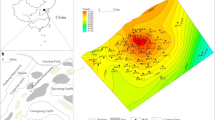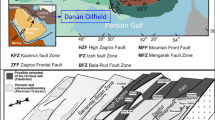Abstract
Fracture-cavity reservoirs can be described in terms of storage space, filling materials and distribution, however, characterizing these variables remains a challenge. In this study, a method was developed to characterize complex reservoirs by integrating outcrop, core, well log, and seismic data from the Tahe oilfield. Outcrop analogs were used to identify and qualitatively analyze the genesis of different reservoir spaces. Cores, well logs, and seismic data were used to identify different types of reservoir space in the subsurface, to describe the spatial distribution, and to establish the distribution pattern of fracture-cavity reservoirs. Clastic sediments, collapse breccia, and chemical fillings were described from the cores and used to assess porosity and permeability. On the basis of the results, a three-dimensional geological model was constructed incorporating a structural model, a reservoir space model, and a property model. Caves and fractures were the main storage spaces and seepage passages. The cave model was built using multi-point geostatistical simulation, while the fracture model was established using deterministic modeling combined with manual interpretations and ant-tracking technology.













Similar content being viewed by others
References
Choquette PW, James NP (1988) Introduction to paleokarst. In: James NP, Choquette PW (eds) Paleokarst. Springer-Verlag, Berlin, pp. 1–24
Ding WL, Lin CS, Qi LX, Huang TZ, Yu TX (2008) Structural framework and evolution of Bachu uplift in Tarim basin. Earth Sci Front 15:242–252
Fritz RD, Wilson JL, Yurewicz DA (1993) Paleokarst related hydrocarbon reservoirs: SEPM Core Workshop 18, p 275
Guardiano F, Srivastava RM (1993) Multivariate geostatistics: beyond bivariate moments. In: Soares A (ed) Geostatistics-Troia, vol 1. Kluwer Academic Publications, Dordrecht, pp. 133–144
Havard DE, Simon JB, Atle R, John AH (2007) From outcrop to reservoir simulation model: workflow and procedures. Geosphere 3:469–490. doi:10.1130/GES00099.1
Hu ZP (2006) Mechanism and distinction method for the seismic “string beads” characteristic. West China Pet Geosci 2:423–426
Hu XY, Li Y, Quan LS, Kong QY, Wang Y, Lv XR (2013) Three-dimensional geological modeling of fractured-vuggy carbonate reservoirs: a case from the Ordovician reservoirs in Tahe-IV block, Tahe oilfield. Oil Gas Geol 34:383–387. doi:10.11743/ogg20130315
Jin ZJ (2006) New progresses in research of China’s typical superimposed basins and reservoiring of hydrocarbons (part 2): taking Tarim Basin as an example. Oil Gas Geol 27:281–288
Journel A, Zhang TF (2006) The necessity of a multiple-point prior model. Math Geosci 38:591–610. doi:10.1007/s11004-006-9031-2
Kang YZ (2005) Cases of discovery and exploration of marine fields in China (part 4): Tahe oilfield in Tarim Basin. Mar Oil Gas Geol 10:31–38
Kerans C (1988) Karst-controlled reservoir heterogeneity in Ellenburger group carbonates of West Texas. AAPG Bull 72:1160–1183
Lang XL, Guo SJ (2013) Fractured reservoir modeling method based on discrete fracture network model. Acta Sci Nat Univ Pekin 49:964–972. doi:10.13209/j.0479-8023.2013.128
Li Y (2012) Ordovician carbonate fracture-cavity reservoirs identification and quantitative characterization in Tahe oilfield. J China Univ Pet 36:1–7. doi:10.3969/j.issn.1673-5005.2012.01.001
Li Y, Fan ZH (2011) Developmental pattern and distribution rule of the fracture-cavity system of Ordovician carbonate reservoirs in the Tahe oilfield. Acta Pet Sin 32:101–106. doi:10.7623/syxb201101015
Liu W, Li YH, Zhang T, Li GR (2002) Study on the sedimentary facies and sequence stratigraphy of the ordovician carbonate rock in Tahe oilfield. Pet Geol Exp 24:104–109
Liu YH, Andrew H, William A, Strebelle S (2004) Multiple-point simulation integration wells, three-dimensional seismic data, and geology. AAPG Bull 88:905–921. doi:10.1306/02170403078
Liu YM, Hou JG, Hu XY, Ma XQ, Zhao B, Qi DS (2012) 3D modeling of paleokarst reservoir in Tahe oilfield. J China Univ Pet 36:34–38 . doi:10.3969/j.issn.1673-5005.2012.02.00644
Loucks RG (1999) Paleocave carbonate reservoirs: burial-depth modifications, spatial complexity, and reservoir implications. AAPG Bull 83:1795–1834
Lu XB, Zhao B, Hu XY, Jin YZ (2012) Studies of 3D reservoir modeling: taking Ordovician carbonate fractured-vuggy reservoirs in Tahe oilfield as an example [J]. Pet Geol Exp 34:193–198
Patric DD, Gerlyn SS, John PC (2002) Outcrop-based reservoir characterization: a composite Phylloid-algal mound, western Orogrande basin (New Mexico). AAPG Bull 86:779–795
Shi JA, Ma BL, Shi YX (1990) Study on the sedimentary environment and diagenesis of upper carboniferous carbonates in Bachu-Keping region, Xinjiang. Acta Sedimentol Sin 8:59–67
Strebelle S (2002) Conditional simulation of complex geological structures using multiple-point statistics. Math Geol 34:1–21. doi:10.1023/A.1014009426274
Suzuki S, Caers J (2008) A distance-based prior model parameterization for constraining solutions of spatial inverse problems, mathematical. Geosciences 40:445–469. doi:10.1007/s11004-008-9154-8
Wu JF, Yao Y, Sa LM (2007) Analysis on seismic response of special cavernous structure of carbonate. Oil Geophys Prospect 42:180–185. doi:10.13810/j.cnki.issn.1000-7210.2007.02.011
Xu W, Cai ZX, Jia ZY, Lin ZM (2010) The study on Ordovician carbonate reservoir karst cavern fillings characterization in Tahe oilfield. Geoscience 24:287–293
Xu WS, Gong B, He C, Qin G (2011) Modeling of reservoir fractures based on discrete fracture network. J Daqing Pet Inst 35:13–16
Yao J, Wang ZS, Zhang Y, Huang CQ (2010) Numerical simulation method of discrete fracture network for naturally fractured reservoirs. Acta Pet Sin 31:284–288. doi:10.7623/syxb201002018
Yun L, Jiang HS (2007) Hydrocarbon accumulation conditions and enrichment rules in Tahe oilfield. Oil Gas Geol 28:768–775
Zhang K (1999) The discovery of Tahe oilfield and its geologic implication. Oil Gas Geol 20:120–124
Zhao M, Kang ZH, Liu J (2008) Modeling and application of fractured-vuggy carbonate reservoirs. Xinjiang Pet Geol 29:318–320
Acknowledgments
This research is supported by National Science and Technology Key Project (2016ZX05014002). The authors wish to express their heartfelt thanks to SINOPEC Exploration and Production Research Institute for supplying core samples and logging data and Institute of Geophysical Prospecting for supplying seismic data.
Author information
Authors and Affiliations
Corresponding author
Rights and permissions
About this article
Cite this article
Li, Y., Hou, J. & Ma, X. Data integration in characterizing a fracture-cavity reservoir, Tahe oilfield, Tarim basin, China. Arab J Geosci 9, 532 (2016). https://doi.org/10.1007/s12517-016-2562-z
Received:
Accepted:
Published:
DOI: https://doi.org/10.1007/s12517-016-2562-z




